The Aventine is the southernmost of the seven hills on which Ancient Rome was built. Despite its proximity to the center of Rome, the hill is one of the most peaceful residential neighborhoods in Rome.
The Aventine hill is best known to visitors for its magnificent views over the city, but there are also some interesting sights, including several churches and a couple of gardens.
History
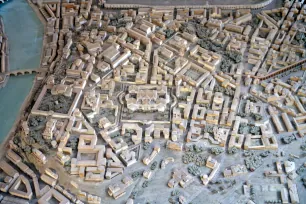
According to the myth of Rome’s foundation, Romulus wanted to found a new city on the Palatine Hill, while his twin brother Remus preferred the Aventine. This disagreement led to a fight in which Romulus killed his brother. As a result, the city of Rome was founded on the Palatine, while for centuries the Aventine remained outside the city limits.
It was first populated in the seventh century BC by refugees of cities that had been conquered by Rome. From 494 BC on it became a preferred residential area for plebeians, the common working class. In 456 BC, a law even assigned the area to the working class. The hill was still outside the city walls until the end of the fourth century BC, when the Servian Wall was built around Rome.
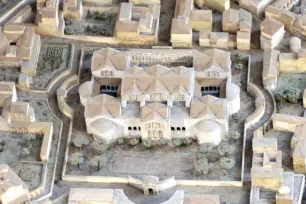
The hill gradually gained importance, and in the late Republican Era this was a favorite place to live for foreign traders and wealthy plebeians. During the Imperial Era the Aventine became more affluent, and some important people lived here, including the future emperor Trajan, as well as his friend Licinius Sura. A couple of bathhouses were built here: the Thermae Suranae (2nd c. AD, named after Sura) near the Circus Maximus and the Thermae Decianae (3rd c. AD, named after emperor Decius), on the top of the hill. There were also several temples on the hill, including temples dedicated to Diana, Minerva, Luna and Juno.
Sights
Aside from some remains of the Servian Wall, there is little left of the buildings from the antiquity.
Santa Sabina
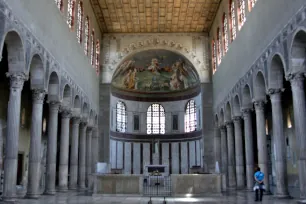
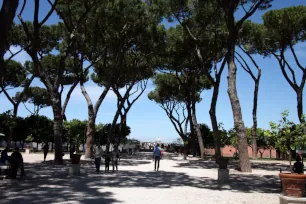
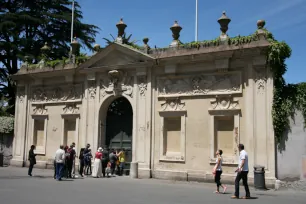
There are however plenty of churches on the Aventine, the most notable being Santa Sabina. This basilica was built in the fifth century on the summit of the hill, on the site of the former house of the Roman martyr Sabina. The church was restored in 1936 to its original appearance. The interior of the church resembles that of a Roman basilica and contains three naves. Of note is the fifth-century wooden door in the narthex, which contains panels with carvings that depict scenes from the bible.
Don’t miss the Fontana del Mascherone di Santa Sabina, a wall fountain in the front yard of the church. The fountain was created in 1593 by Giacomo della Porta. It combines an ancient Roman bathtub with a marble disc that shows a man’s face, integrated in a huge shell.
Garden of the Oranges
A doorway near the wall fountain leads to the Giardino degli Aranci (Garden of the Oranges). The first orange trees were allegedly grown here in the thirteenth century by Dominican friars, who had brought seeds from Spain.
The garden is now officially known as parco Savello. Its current layout dates from 1932, when the garden was made accessible to the public. From here you have splendid views over Rome and in particular the dome of the St. Peter’s Basilica.
Villa of the Military order of Malta
Walk to the Piazza dei Cavalieri di Malta and chances are you’ll see people queuing to see another celebrated view of the dome of the St. Peter’s Basilica, this time by peering through a small hole in the main gate of the Villa del Priorato di Malta (Villa of the priory of the Military order of Malta).

The villa is one of several buildings in Rome owned by the order of Malta, a military order founded in the eleventh century to take care of the sick and wounded in the Holy Land. The order had its headquarters in Malta until 1798, when they were expulsed by Napoleon and moved to Rome. The property is on extraterritorial land and not accessible to the public. You also need permission to access the Santa Maria del Priorato, a small church of the Maltese order situated on the estate.
In 1764 the Grand Master of the Maltese order, who was a nephew of Pope Clement XIII, commissioned the restoration of the church. The work was assigned to the Venetian artist Giovanni Battista Piranesi, who came up with a Neoclassical design. At the same time the artist, who is best known for his etches of Ancient Roman structures, also created the Piazza dei Cavalieri di Malta, the square in front of the villa.
Sant’Anselmo
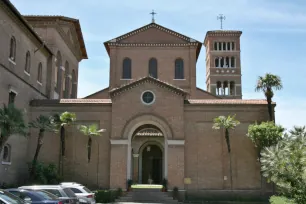
Across this square from the villa is the abbey of Sant’Anselmo, a Benedictine complex with several gardens that was built on land given to the Benedictines by the Maltese order. The brick church of Sant’Anselmo was built in 1892-1896 to a design by the Italian architect Francesco Vespignani. The church services are known for the Gregorian chants of Benedictine monks.
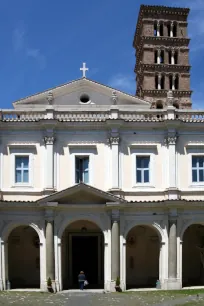
Sant’Alessio
Right next to the Villa of the Military order of Malta is another, somewhat more interesting church: Santi Bonifacio e Alessio, dedicated to Saint Boniface and Saint Alexius. The church is built on the site of the house where Alexius, the son of a wealthy senator, had lived. Refusing an arranged marriage, he fled on a pilgrimage to the East. Years later he returned and, unrecognized, was granted shelter by his father. He stayed as a servant and lived under a staircase in his former parental home until he died seventeen years later.
The history of the church goes back to the fifth century or even before. The church was restored many times, first in 1217 when the Romanesque clock tower was built. The contrasting portico dates from the sixteenth century. Inside you can see a statue of Saint Alexius under what is believed to be the actual staircase he lived under.
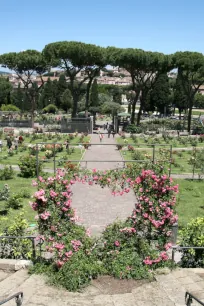
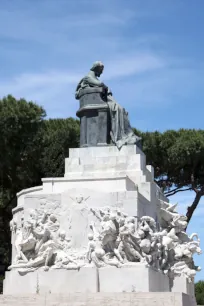
Rose Garden
On the slope of the Aventine hill facing the Circus Maximus lies the Roseto di Roma Capitale, the communal Rose Garden of the city of Rome. The rose garden is situated near the site of the former temple of Flora, which was dedicated to the goddess of flowers. This was also where in ancient times the Floralia was held, an annual festival that celebrated spring.
The garden was created in 1950 to replace the communal garden on the Colle Oppio that was destroyed during the Second World War. The garden contains more than one thousand roses, with varieties from all corners of the world.
Mazzini Monument
Nearby, overlooking the Circus Maximus, is a massive marble monument that honors the nineteenth-century politician Giuseppe Mazzini. Mazzini was one of the main figures of the unification of Italy, which, in his eyes, was the first step towards the unification of Europe.
Work on the monument started in 1922, but it was repeatedly interrupted due to opposition by the Fascist government and when the sculptor Ettore Ferrari died in 1929, the project was abandoned. It was picked up again after the war by Ferrari’s son Gian Giacomo and sculptor Ettore Guastalla, a student of Ferrari.
The monument was eventually inaugurated in 1949 and shows Mazzini seated on top of a huge stepped marble pedestal decorated with large reliefs that celebrate the unification of Italy.
- Next: Botanical Garden
- More Sights & Attractions in Rome

